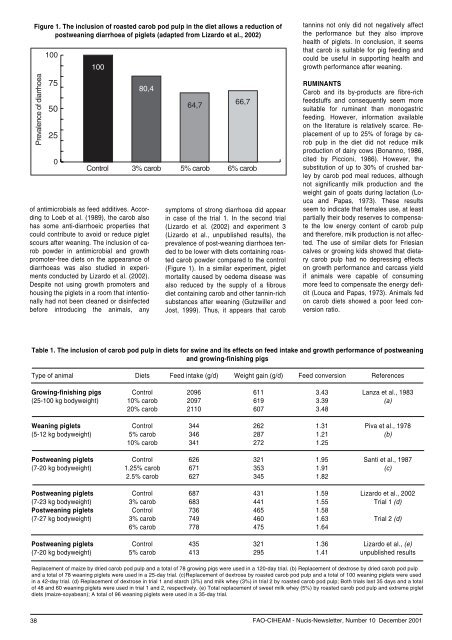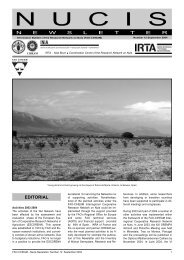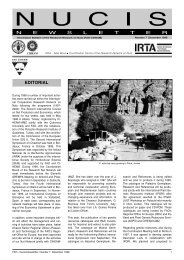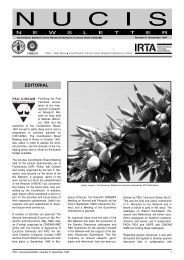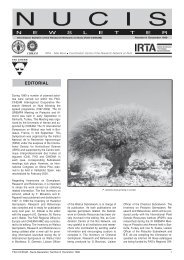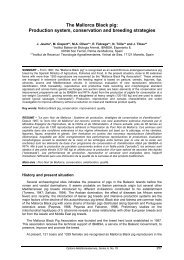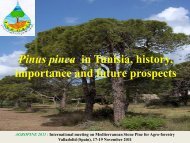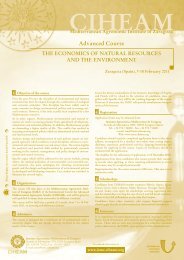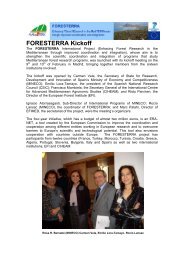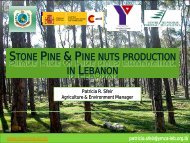NUCIS number 10. December 2001. 48 pages (full ... - IAMZ - ciheam
NUCIS number 10. December 2001. 48 pages (full ... - IAMZ - ciheam
NUCIS number 10. December 2001. 48 pages (full ... - IAMZ - ciheam
Create successful ePaper yourself
Turn your PDF publications into a flip-book with our unique Google optimized e-Paper software.
Figure 1. The inclusion of roasted carob pod pulp in the diet allows a reduction of<br />
postweaning diarrhoea of piglets (adapted from Lizardo et al., 2002)<br />
Prevalence of diarrhoea<br />
100<br />
75<br />
50<br />
25<br />
0<br />
100<br />
Control<br />
80,4<br />
of antimicrobials as feed additives. According<br />
to Loeb et al. (1989), the carob also<br />
has some anti-diarrhoeic properties that<br />
could contribute to avoid or reduce piglet<br />
scours after weaning. The inclusion of carob<br />
powder in antimicrobial and growth<br />
promoter-free diets on the appearance of<br />
diarrhoeas was also studied in experiments<br />
conducted by Lizardo et al. (2002).<br />
Despite not using growth promoters and<br />
housing the piglets in a room that intentionally<br />
had not been cleaned or disinfected<br />
before introducing the animals, any<br />
64,7<br />
66,7<br />
3% carob 5% carob 6% carob<br />
symptoms of strong diarrhoea did appear<br />
in case of the trial 1. In the second trial<br />
(Lizardo et al. (2002) and experiment 3<br />
(Lizardo et al., unpublished results), the<br />
prevalence of post-weaning diarrhoea tended<br />
to be lower with diets containing roasted<br />
carob powder compared to the control<br />
(Figure 1). In a similar experiment, piglet<br />
mortality caused by oedema disease was<br />
also reduced by the supply of a fibrous<br />
diet containing carob and other tannin-rich<br />
substances after weaning (Gutzwiller and<br />
Jost, 1999). Thus, it appears that carob<br />
tannins not only did not negatively affect<br />
the performance but they also improve<br />
health of piglets. In conclusion, it seems<br />
that carob is suitable for pig feeding and<br />
could be useful in supporting health and<br />
growth performance after weaning.<br />
RUMINANTS<br />
Carob and its by-products are fibre-rich<br />
feedstuffs and consequently seem more<br />
suitable for ruminant than monogastric<br />
feeding. However, information available<br />
on the literature is relatively scarce. Replacement<br />
of up to 25% of forage by carob<br />
pulp in the diet did not reduce milk<br />
production of dairy cows (Bonanno, 1986,<br />
cited by Piccioni, 1986). However, the<br />
substitution of up to 30% of crushed barley<br />
by carob pod meal reduces, although<br />
not significantly milk production and the<br />
weight gain of goats during lactation (Louca<br />
and Papas, 1973). These results<br />
seem to indicate that females use, at least<br />
partially their body reserves to compensate<br />
the low energy content of carob pulp<br />
and therefore, milk production is not affected.<br />
The use of similar diets for Friesian<br />
calves or growing kids showed that dietary<br />
carob pulp had no depressing effects<br />
on growth performance and carcass yield<br />
if animals were capable of consuming<br />
more feed to compensate the energy deficit<br />
(Louca and Papas, 1973). Animals fed<br />
on carob diets showed a poor feed conversion<br />
ratio.<br />
Table 1. The inclusion of carob pod pulp in diets for swine and its effects on feed intake and growth performance of postweaning<br />
and growing-finishing pigs<br />
Type of animal Diets Feed intake (g/d) Weight gain (g/d) Feed conversion References<br />
Growing-finishing pigs Control 2096 611 3.43 Lanza et al., 1983<br />
(25-100 kg bodyweight) 10% carob 2097 619 3.39 (a)<br />
20% carob 2110 607 3.<strong>48</strong><br />
Weaning piglets Control 344 262 1.31 Piva et al., 1978<br />
(5-12 kg bodyweight) 5% carob 346 287 1.21 (b)<br />
10% carob 341 272 1.25<br />
Postweaning piglets Control 626 321 1.95 Santi et al., 1987<br />
(7-20 kg bodyweight) 1.25% carob 671 353 1.91 (c)<br />
2.5% carob 627 345 1.82<br />
Postweaning piglets Control 687 431 1.59 Lizardo et al., 2002<br />
(7-23 kg bodyweight) 3% carob 683 441 1.55 Trial 1 (d)<br />
Postweaning piglets Control 736 465 1.58<br />
(7-27 kg bodyweight) 3% carob 749 460 1.63 Trial 2 (d)<br />
6% carob 778 475 1.64<br />
Postweaning piglets Control 435 321 1.36 Lizardo et al., (e)<br />
(7-20 kg bodyweight) 5% carob 413 295 1.41 unpublished results<br />
Replacement of maize by dried carob pod pulp and a total of 78 growing pigs were used in a 120-day trial. (b) Replacement of dextrose by dried carob pod pulp<br />
and a total of 78 weaning piglets were used in a 25-day trial. (c)Replacement of dextrose by roasted carob pod pulp and a total of 100 weaning piglets were used<br />
in a 42-day trial. (d) Replacement of dextrose in trial 1 and starch (3%) and milk whey (3%) in trial 2 by roasted carob pod pulp; Both trials last 35 days and a total<br />
of <strong>48</strong> and 60 weaning piglets were used in trial 1 and 2, respectively. (e) Total replacement of sweet milk whey (5%) by roasted carob pod pulp and extreme piglet<br />
diets (maize-soyabean); A total of 96 weaning piglets were used in a 35-day trial.<br />
38 FAO-CIHEAM - Nucis-Newsletter, Number 10 <strong>December</strong> 2001


